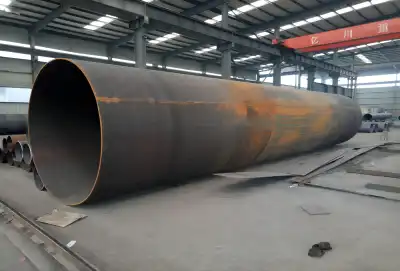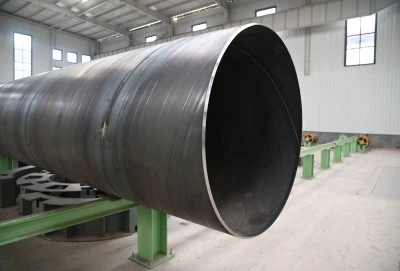Manufacturing process:
The manufacturing processes for straight seam welded pipes and spiral weld pipes are fundamentally different, each with its own unique characteristics and advantages. Understanding these differences is crucial for selecting the right type of pipe for specific applications in various industries.
Straight welded steel pipes, also known as longitudinal welded pipes, are formed by rolling steel plates or steel strips into round tubes and then welding them along the longitudinal direction of the steel pipe. This process begins with flat steel plates or coils that are carefully selected based on the required specifications of the final product. The steel is first shaped into a cylindrical form using powerful rolling machines. Once the desired shape is achieved, the edges of the steel are brought together and welded along the entire length of the pipe.
The welding process for straight seam pipes typically employs one of several methods, including Electric Resistance Welding (ERW) for smaller diameter pipes, or Submerged Arc Welding (SAW) for larger diameter pipes with thicker walls. In ERW, the edges of the steel are heated to welding temperature using electric current and then pressed together to form a solid-state weld. SAW, on the other hand, uses a continuously fed electrode wire and granular flux to create a strong, high-quality weld seam.
In contrast, spiral welded pipes are formed by rolling steel strips into a specific spiral angle and then continuously welding them along the circumference of the steel pipe to form a spiral weld. This process begins with a long, narrow strip of steel that is fed into a forming machine at a predetermined angle. As the strip moves through the machine, it is gradually curved and shaped into a tubular form, with the edges of the strip meeting in a helical pattern around the pipe's circumference.
The welding of spiral pipes is typically done using the Submerged Arc Welding (SAW) process, similar to large-diameter straight seam pipes. A spiral stitch that runs through the entire course of the pipe is generated in this particular case, nevertheless, since fusing is done frequently as the conduit is established. This spiral formation allows for the production of large diameter pipes using narrower steel strips, which can be advantageous in terms of material availability and cost.
|
|
|
Weld shape:
One of the most visually distinctive differences between straight seam welded pipes and spiral weld pipes is the shape and orientation of their weld seams. This difference in weld geometry not only affects the appearance of the pipes but also influences their structural characteristics and performance in various applications.
In straight welded steel pipes, the weld is a straight line extending along the longitudinal direction of the steel pipe. This single, continuous weld runs parallel to the pipe's axis from one end to the other. The straightness of this weld allows for easier inspection and quality control during manufacturing. It also facilitates simpler joint preparation and field welding when connecting pipes in a pipeline system.
The longitudinal weld in straight seam pipes is typically designed to be as strong as or stronger than the base metal of the pipe. This is achieved through careful control of welding parameters and, in some cases, post-weld heat treatment. The straight weld configuration allows for efficient distribution of stresses along the pipe's length, particularly when the pipe is subjected to internal pressure.
On the other hand, the weld of spiral welded pipes is spiral-shaped and surrounds the circumference of the steel pipe. This helical weld pattern creates a distinctive appearance that is easily recognizable. The spiral weld typically forms an angle of about 30 to 45 degrees with the pipe's longitudinal axis, although this angle can be adjusted based on the specific manufacturing process and desired pipe properties.
The spiral weld configuration offers several advantages. First, it allows for the use of narrower steel strips to produce large diameter pipes, which can be beneficial in terms of material sourcing and cost. Additionally, the spiral weld distributes stresses more evenly around the circumference of the pipe, which can enhance its resistance to external loads and provide improved structural stability.
However, the spiral weld pattern can present challenges in certain applications. For instance, it may complicate the process of making branch connections or repairs in the field. The intersecting of the spiral weld with a circumferential field weld can also require more careful attention during pipeline construction to ensure proper joint integrity.
Production efficiency:
The production efficiency of straight welded steel pipes and spiral welded pipes differs significantly, with each type having its own advantages in terms of manufacturing speed and output capacity. These differences in production efficiency can have implications for cost, lead times, and suitability for different project scales.
The production process of straight welded steel pipes is relatively simple compared to spiral welded pipes. This simplicity translates to high production efficiency, making straight welded pipes suitable for rapid production. The straightforward nature of the manufacturing process allows for quicker setup times and easier adjustments to produce different pipe sizes.
In straight seam welding, once the steel plate or strip is formed into a cylindrical shape, the welding process can proceed quickly along the length of the pipe. This is particularly true for smaller diameter pipes produced using Electric Resistance Welding (ERW), where the welding speed can be very high. Even for larger diameter pipes using Submerged Arc Welding (SAW), the welding process is still relatively fast and efficient.
The simplicity of the straight welding process also allows for easier implementation of automation and robotics, further enhancing production efficiency. This can lead to lower production costs per unit, especially for large volume orders of pipes with consistent specifications.
In contrast, the production process of spiral welded pipes is more complex. The need to form the steel strip into a helical shape and continuously weld along this spiral path requires more sophisticated machinery and control systems. This complexity can result in longer setup times and more challenging adjustments when changing pipe specifications.
However, despite the more intricate production process, spiral welded pipe manufacturing offers a significant advantage in terms of continuous production capability. Once the process is set up and running, it can operate continuously, feeding steel strip and producing pipe without interruption. This continuous production model is particularly well-suited for mass production scenarios, where large quantities of pipe with consistent specifications are required.
The continuous nature of spiral pipe production can lead to high overall output volumes, even if the production speed for individual pipes might be slower than for straight welded pipes. This makes spiral welded pipes an attractive option for large-scale projects that require substantial quantities of pipe, such as long-distance pipelines or major infrastructure developments.
Weld length and production speed:
The weld length and production speed are important factors that distinguish straight seam welded pipes from spiral weld pipes. These characteristics not only affect the manufacturing process but also influence the properties and applications of the final product.
In straight welded steel pipes, the weld seam runs along the longitudinal axis of the pipe. As a result, the weld length is equal to the length of the pipe itself. This relatively shorter weld length compared to spiral welded pipes offers several advantages in terms of production speed and efficiency.
The shorter weld length in straight seam pipes allows for faster production speeds. With only one continuous weld to make along the length of the pipe, welding can be completed quickly, especially for smaller diameter pipes using high-speed welding methods like Electric Resistance Welding (ERW). Even for larger diameter pipes using Submerged Arc Welding (SAW), the straight seam configuration allows for efficient welding processes.
This faster production speed makes straight welded pipes particularly suitable for projects that require quick turnaround times or have tight schedules. It also allows manufacturers to respond more rapidly to changes in demand or specifications, as the production line can be adjusted relatively quickly to produce different pipe sizes or grades.
On the other hand, spiral welded pipes have a significantly longer weld length due to their helical weld pattern. The weld seam wraps around the circumference of the pipe in a spiral fashion, resulting in a weld length that is considerably longer than the pipe itself. This longer weld length has several implications for the production process and the characteristics of the final product.
The extended weld length in spiral pipes generally results in a slower production speed compared to straight welded pipes. The welding process must keep pace with the continuous forming of the pipe from the steel strip, which limits the overall speed of production. However, this slower speed is offset by the continuous nature of the production process, which allows for uninterrupted manufacturing once the line is set up and running.
While the production speed for individual pipes may be slower, the continuous production capability of spiral welded pipe manufacturing can lead to high overall output volumes. This makes spiral welded pipes particularly well-suited for large-scale projects that require substantial quantities of pipe with consistent specifications.
The longer weld length in spiral pipes can also provide some advantages in terms of pipe performance. The helical weld pattern distributes stresses more evenly around the circumference of the pipe, which can enhance its resistance to external loads and provide improved structural stability. This can be particularly beneficial in applications where the pipe may be subjected to bending or other complex loading conditions.
Size Limitations:
The size limitations of straight seam welded pipes and spiral weld pipes are an important consideration in pipe selection, as they can significantly impact the feasibility and efficiency of various projects. These limitations are primarily determined by the manufacturing processes and the available raw materials.
For straight seam welded steel pipes, the diameter is usually limited by the width of the steel plate or coil used in production. The maximum pipe diameter that can be produced is directly related to the width of the available steel plate. This limitation arises from the fact that the plate must be wide enough to be rolled into a cylinder of the desired diameter, with enough material left over for proper edge preparation and welding.
Typical plate rolling equipment can handle steel plates up to about 5 meters (16 feet) wide, which translates to a maximum pipe diameter of approximately 150 inches (3.8 meters) for straight seam welded pipes. While larger diameters are technically possible, they require specialized equipment and are not commonly produced.
This size limitation can be a significant factor in large-scale pipeline projects or industrial applications that require very large diameter pipes. In such cases, project engineers must carefully consider whether straight seam welded pipes can meet the required specifications or if alternative solutions need to be explored.
In contrast, spiral welded pipes offer more flexibility in terms of diameter range. Spiral welded pipe can produce larger diameter steel pipes using narrower steel strips. This is because the spiral forming process allows for the creation of large diameter pipes from relatively narrow steel coils.
The spiral welding process can theoretically produce pipes of almost any diameter, limited only by the capabilities of the forming and welding equipment. In practice, spiral welded pipes are commonly produced in diameters ranging from 16 inches (406 mm) to over 100 inches (2540 mm), with some manufacturers capable of producing pipes up to 140 inches (3556 mm) in diameter.
This ability to produce large diameter pipes from narrower steel strips offers several advantages. It can reduce material costs, as narrower steel strips are often more readily available and may be less expensive than very wide steel plates. It also provides more flexibility in sourcing raw materials, as the production is not dependent on the availability of extremely wide steel plates.
Furthermore, the spiral welding process allows for easier adjustment of pipe diameter during production. By changing the spiral angle at which the steel strip is fed into the forming machine, manufacturers can produce pipes of different diameters using the same steel coil width. This flexibility can be particularly advantageous for projects that require pipes of varying diameters.
Straight seam welded pipe exporter:
Longma's offering of multiple welding types (ERW, LSAW, SSAW) demonstrates their ability to meet diverse customer needs across various industries. Their technical expertise and quality control processes ensure that their pipes meet stringent industry standards and customer specifications.
If you're in the process of selecting a welded pipe manufacturer for your project, whether you need straight seam or spiral welded pipes, you can reach out to Longma at info@longma-group.com for more information about their products, services, and how they can meet your specific requirements.














